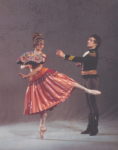Alonso, Alicia
Alicia Alonso Photos
Introduction
Alicia Alonso stands as a towering figure in the world of ballet, renowned for her extraordinary talent, resilience, and visionary contributions to the art form. Born on December 21, 1920, and passing away on October 17, 2019, Alonso’s career spanned over seven decades, during which she not only captivated audiences with her performances but also played a pivotal role in establishing Cuban ballet on the global stage. Her legacy includes founding the Ballet Nacional de Cuba and her indelible influence on the technique and artistry of ballet dancers worldwide.
Early Life and Background
Alicia Alonso was born Alicia Ernestina de la Caridad del Cobre Martínez del Hoyo in Havana, Cuba. Growing up in a culturally rich environment, she was exposed to the arts from a young age. Her family, particularly her mother, encouraged her artistic pursuits, which led to her initial introduction to dance. Alonso began her ballet training at the age of nine at the Sociedad Pro-Arte Musical in Havana, where she quickly demonstrated her prodigious talent.
Her early mentors included Nikolai Yavorsky, a former dancer with the Bolshoi Ballet, and later, she continued her training in the United States under the tutelage of Alexandra Fedorova and Enrico Zanfretta. These formative years were crucial in shaping her technical prowess and artistic sensibilities.
Rise to Prominence
Alicia Alonso’s rise to prominence began with her association with the American Ballet Theatre (ABT) in New York City. She joined the company in 1940 and quickly gained attention for her exceptional technique and expressive performances. Her breakthrough came in 1943 when she stepped in for the injured Alicia Markova in the role of Giselle. Despite battling vision problems that would later define much of her career, Alonso’s performance was met with critical acclaim, establishing her as a leading ballerina.
Throughout the early stages of her career, Alonso faced significant challenges, including deteriorating eyesight that required multiple surgeries. However, her determination and resilience allowed her to overcome these obstacles, and she continued to perform at the highest level.
Career Highlights
Alicia Alonso’s career is marked by numerous highlights that solidified her status as one of the greatest ballerinas of the 20th century. Her signature roles included Giselle, Carmen, and Odette/Odile in Swan Lake. Each performance was characterized by her impeccable technique, emotional depth, and dramatic intensity.
Alonso collaborated with some of the most renowned choreographers and composers of her time, including George Balanchine, Michel Fokine, and Igor Stravinsky. Her partnerships with fellow dancers such as Igor Youskevitch and Erik Bruhn were also highly celebrated.
Throughout her career, Alonso received numerous awards and honors, including the Dance Magazine Award, the Grand Prix de la Ville de Paris, and the Order of José Martí, Cuba’s highest civilian honor. Her impact on the development of ballet during her era was profound, as she brought a unique blend of technical precision and passionate artistry to her performances.
Style and Technique
Alicia Alonso’s style and technique were distinguished by their elegance, precision, and emotional expressiveness. She was known for her ability to convey deep emotion through her movements, making her performances both technically flawless and profoundly moving. Her technique was characterized by strong, clean lines, impeccable footwork, and a remarkable ability to maintain balance and control, even with her vision impairment.
Alonso’s influence on the field of ballet extended beyond her performances. She was a master teacher and coach, known for her rigorous training methods and her ability to inspire and nurture young talent. Her contributions to ballet through innovation and mastery have left an indelible mark on the art form.
Repertoire
- Giselle
- Carmen
- Swan Lake (Odette/Odile)
- Don Quixote (Kitri)
- La Fille Mal Gardée
- Sleeping Beauty (Aurora)
Legacy and Influence
Alicia Alonso is remembered as a pioneering figure in the ballet community, whose influence extends far beyond her performances. She played a crucial role in the establishment and development of the Ballet Nacional de Cuba, which has become one of the world’s leading ballet companies. Her dedication to nurturing young talent and promoting Cuban ballet on the international stage has had a lasting impact on the cultural and artistic landscape.
Alonso’s influence on future generations of dancers and choreographers is profound. Many of her students have gone on to have successful careers in ballet, carrying forward her legacy of excellence and innovation. Her contributions to the evolution of ballet have ensured that her influence will be felt for generations to come.
Personal Life and Anecdotes
Outside of her illustrious career, Alicia Alonso was known for her strong personality, determination, and passion for the arts. She was married to fellow dancer Fernando Alonso, with whom she co-founded the Ballet Nacional de Cuba. Their partnership was both personal and professional, and together they made significant contributions to the world of ballet.
One notable anecdote from Alonso’s life is her determination to continue dancing despite her vision impairment. She developed a unique system of using stage lights and floor markings to navigate the stage, allowing her to perform with precision and grace even when she could barely see. This remarkable resilience and ingenuity are a testament to her dedication to her art.
Later Years and Retirement
After retiring from performing, Alicia Alonso continued to contribute to the world of ballet through teaching, coaching, and choreography. She remained actively involved with the Ballet Nacional de Cuba, serving as its director and guiding the company to international acclaim. Her later years were marked by numerous accolades and recognitions, including honorary doctorates and lifetime achievement awards.
Alicia Alonso passed away on October 17, 2019, at the age of 98. Her passing was mourned by the ballet community worldwide, and she was remembered as a trailblazer who had left an indelible mark on the art form. Posthumously, she continues to be celebrated for her extraordinary contributions to ballet.
FAQ
What makes Alicia Alonso so famous?
Alicia Alonso is famous for her exceptional talent, resilience, and visionary contributions to ballet. She is renowned for her performances in roles such as Giselle and Carmen, as well as for founding the Ballet Nacional de Cuba.
Which roles is Alicia Alonso best known for?
Alicia Alonso is best known for her roles in Giselle, Carmen, and Swan Lake (Odette/Odile). These performances showcased her technical prowess and emotional depth.
How has Alicia Alonso contributed to the evolution of ballet?
Alicia Alonso has contributed to the evolution of ballet through her innovative performances, rigorous training methods, and her role in establishing the Ballet Nacional de Cuba. Her influence extends to future generations of dancers and choreographers.
What are the key challenges faced by Alicia Alonso in her career?
Alicia Alonso faced significant challenges, including vision impairment that required multiple surgeries. Despite these obstacles, she continued to perform at the highest level and made significant contributions to ballet.
How is Alicia Alonso currently influencing the ballet community?
Although Alicia Alonso has passed away, her influence continues through the Ballet Nacional de Cuba and the many dancers she trained and inspired. Her legacy lives on in the world of ballet.
When was Alicia Alonso born?
Alicia Alonso was born on December 21, 1920.
When did Alicia Alonso pass away?
Alicia Alonso passed away on October 17, 2019.
Conclusion
Alicia Alonso’s enduring impact on ballet is a testament to her extraordinary talent, resilience, and visionary contributions. Her performances, teaching, and leadership have left an indelible mark on the art form, ensuring that her legacy will continue to inspire future generations of dancers and choreographers. As we reflect on her remarkable career, we are reminded of the profound influence she has had on the world of ballet and the cultural landscape at large. For those who wish to explore more about her work, there is a wealth of performances and recordings that capture the essence of her artistry and dedication to ballet.




